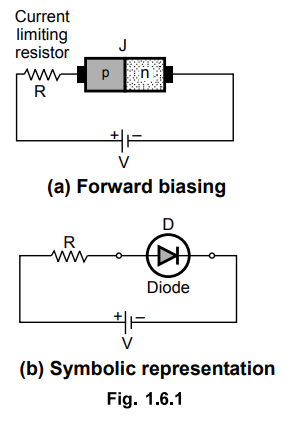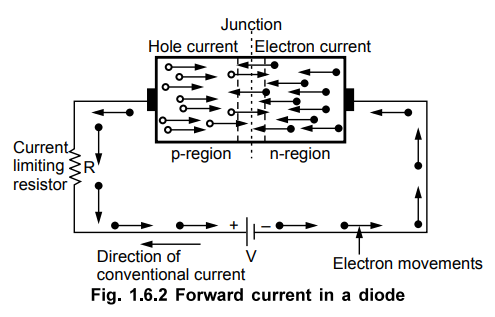Electron Devices and Circuits: Unit I: PN Junction Devices
Forward Biasing of P-N Junction Diode
Key Point : Forward biasing means connecting p-region to +ve and n-region to -ve of the battery.
Forward Biasing of P-N Junction Diode
AU
: May-06,07,08,09,10, Dec.-05,06,07,12,14,15
•
If an external d.c. voltage is connected in such a way that the p-region
terminal is connected to the positive of the d.c. voltage and the n-region is
connected to the negative of the d.c. voltage, the biasing condition is called forward
biasing. The p-n junction is said to be forward biased.
Key
Point : Forward biasing means connecting p-region to +ve
and n-region to -ve of the battery.
•
The Fig. 1.6.1 (a) shows the connection of forward biasing of a p-n junction.
To limit the current, practically a current limiting resistor is connected in
series with the p-n junction diode. The Fig. 1.6.1 (b) shows the symbolic
representation of a forward biased diode.

1. Operation of Forward Biased Diode
•
When the p-n junction is forward biased as long as the applied voltage is less
than the barrier potential, there cannot be any conduction.
•
When the applied voltage becomes more than the barrier potential, the negative
terminal of battery pushes the free electrons against barrier potential from n
to p-region. Similarly positive terminal pushes the holes from p to n-region.
Thus holes get repelled by positive terminal and cross the junction against
barrier potential. Thus the applied voltage overcomes the barrier potential.
This reduces the width of depletion region.
•
As forward voltage is increased, at a particular value the depletion region
becomes very much narrow such that large number of majority charge carriers can
cross the junction.
•
The large number of majority carriers constitute a current called forward
current. Once the conduction electrons enter the p-region, they become valence
electrons. Then they move from hole to hole towards the positive terminal of
the battery. The movement of valence electrons is nothing but movement of holes
in opposite direction to that of electrons, in the p-region. So current in the
p-region is the movement of holes which are majority carriers. This is the hole
current. While the current in the n-region is the movement of free electrons
which are majority carriers. This is the electron current. Hence the overall
forward current is due to the majority charge carriers. The action is shown in
the Fig. 1.6.2. These majority carriers can then travel around the closed
circuit and a relatively large current flows. The direction of flow of
electrons is from negative to positive of the battery. While direction of the
conventional current is from positive to negative of the battery as shown in
the Fig. 1.6.2.

Key
Point : The direction of flow of electrons and
conventional current is opposite to each other.
2. Effect on the Depletion Region
•
Due to the forward bias voltage, more electrons flow into the depletion region,
which reduces the number of positive ions. Similarly flow of holes reduces the
number of negative ions. This reduces the width of the depletion region. This
is shown in the Fig. 1.6.3.

Key
Point : Depletion region narrows due to forward bias
voltage.
3. Effect of the Barrier Potential
•
Under the influence of applied forward bias voltage, the free electrons get the
energy equivalent to the barrier potential so that they can easily overcome the
barrier, which is a sort of a hill and cross the junction. While crossing the
junction, the electrons give up the amount of energy equivalent to the barrier
potential. This loss of energy produces a voltage drop across the p-n junction
which is almost equal to the barrier potential.
Key Point: The polarities of voltage
drop across the p-n junction in forward biased condition are opposite to that
of barrier potential but the value is almost equal to the barrier potential.
•
Due to the internal resistance, there is additional small voltage drop across
the diode.
•
Thus the total voltage drop across a p-n junction diode in a forward biased
condition is Vf and it is made up of
1.
Drop due to barrier potential.
2.
Drop due to internal resistance.
Vf
= Vr + If rf
Key
Point : The total Vf is of the order of 0.7 V for
silicon and 0.3 V for the germanium.
4. Forward V-l Characteristics of Diode
•
The response of p-n junction can be easily indicated with the help of
characteristics called V-I characteristics of p-n junction. It is the graph of
voltage applied across the p-n junction and the current flowing through the p-n
junction.
• The Fig. 1.6.4 shows the forward biased diode. The applied voltage is V while the voltage across the diode is Vf. The current flowing in the circuit is the forward current If. The graph of forward current If against the forward voltage Vf across the diode is called forward characteristics of a diode.

•
The forward characteristics of a diode is shown in the Fig. 1.6.5.

•
Basically forward characteristics can be divided into two regions :
1.
Region O to P : As long as Vf is less than cut-in voltage (Vy), the current
flowing is very small. Practically this current is assumed to be zero.
2.
Region P to Q and onwards : As Vf increases towards V, the width of depletion
region goes on reducing. When Vf exceeds V, i.e. cut-in voltage, the depletion
region becomes very thin and current If increases suddenly. This increase in
the current is exponential as shown in the Fig. 1.6.5 by the region P to Q.
•
The point P, after which the forward current starts increasing exponentially is
called knee of the curve.
Key
Point : The normal forward biased operation of the diode
is above the knee point of the curve, i.e. in the region P-Q.
•
The forward current is the conventional current, hence it is treated as
positive and the forward voltage Vf is also treated positive. Hence the forward
characteristics is plotted in the first quadrant.
5. Forward Resistance of Diode
•
The resistance offered by the p-n junction diode in forward biased condition is
called forward resistance. The forward resistance is defined in two ways :
1)
Static forward resistance :
•
This is the forward resistance of p-n junction diode when p-n junction is used
in d.c. circuit and the applied forward voltage is d.c. This resistance is
denoted as Rf and is calculated at a particular point on the forward
characteristics.
•
Thus at a point E shown in the forward characteristics, the static resistance
Rf is defined as the ratio of the d.c. voltage applied across the p-n junction
to the d.c. current flowing through the p-n junction.
Rf
= Forward d.c. voltage / Forward d.c. current = OA / OC at point E
2)
Dynamic forward resistance :
•
The resistance offered by the p-n junction under a.c. conditions is called
dynamic resistance denoted as rf.
Key
Point : The dynamic resistance is reciprocal of the
slope of the forward characteristics.
•
Consider the change in applied voltage from point A to B shown in the Fig.
1.6.5. This is denoted as Δ Vf. The corresponding change in the
forward current is from point C to D. It is denoted as A If. Thus the slope of
the characteristics is ΔIf/ΔVf. The reciprocal of the
slope is dynamic resistance rf.
rf
= ΔVf / ΔLf = 1 /
(Δ If/ ΔVf)
=
1 / Slope of forward characteristics
Key
Point : Generally the value of rf is very small of the
order of few ohms, in the operating region i. e.
above the knee.
Review Questions
1. With a neat diagram explain the working of a PN junction
diode in forward bias condition.
AU : May-06,07,08,09,10,Dee.-05,06,12,14,15, Marks 5
2. Explain the static and dynamic resistances of the
AU : Dec.-07, Marks 8
3. Explain the effect of the barrier potential in a forward
biased diode.
Electron Devices and Circuits: Unit I: PN Junction Devices : Tag: : - Forward Biasing of P-N Junction Diode
Related Topics
Related Subjects
Electron Devices and Circuits
EC3301 3rd Semester EEE Dept | 2021 Regulation | 3rd Semester EEE Dept 2021 Regulation
